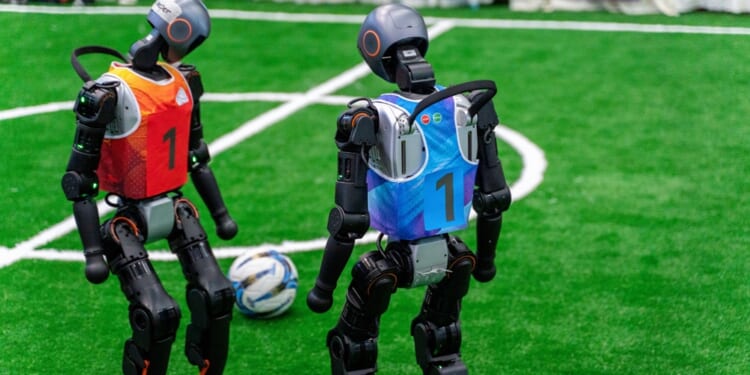China’s humanoid robot games were mocked online—but behind the spectacle lies Beijing’s real plan: to dominate AI, robotics, and future military power.
At the World Humanoid Robot Games held in Beijing in August 2025, a boxing robot flailed its fists at empty air before toppling onto the mat. Online, the world chuckled. But this comical display of technological immaturity may yet prove to be one of the most dangerously misleading spectacles of the year. While the world’s attention was fixated on war in Ukraine and high-stakes diplomacy in Gaza, this seemingly minor event may prove to be one of the decisive inflection points in determining global power for decades.
It was easy to laugh at the glitches—the automaton face-plants during the opening ceremony, the robot soccer players stumbling over the ball, and the housekeeping bots struggling simply to open a door. But to dismiss China’s robotics ambitions based on these clumsy prototypes would be a profound error.
Don’t Mistake Clumsiness for Weakness
This public spectacle reflecting the messy reality of nascent technology risks encouraging observers to underestimate progress. Dismissing China’s efforts based on current stumbles would be shortsighted in the extreme, given the rapid improvement and massive resources deployed.
That this historic competition took place in Beijing—not Silicon Valley or Boston, not Augsburg, Germany (formerly the home of KUKA Robotics) or Oshino, Japan (headquarters of FANUC Corporation)—is no accident. It signals China’s determination to establish a commanding lead in the technologies that will define the twenty-first century: artificial intelligence (AI), robotics, computing, and biotech.
The United States retains formidable advantages—from Boston Dynamics to NVIDIA’s chips to world-class universities. The question is whether America will deploy these assets strategically.
Chinese robotics company Unitree dominated the competition, with its humanoid robots winning first place in the 4x100m relay, along with three other gold medals in track and field events, showcasing capabilities once confined to science fiction. These seemingly benign athletic demonstrations mask a profound strategic reality: the same technologies enabling robots to coordinate in relay races will inevitably enable autonomous systems to coordinate in combat scenarios. Robot-on-robot warfare, once confined to science fiction, is becoming increasingly plausible as these technologies mature. While Western policymakers debate redrawing territorial boundaries in Europe, Chinese engineers are erasing the boundaries between human and machine intelligence for autonomous kill—a far more profound frontier for global competition and the future of warfare.
A Coordinated Strategy for Technological Dominance
The robotics competition reveals a broader pattern. Beijing’s dominance in humanoid robotics isn’t an isolated achievement—it’s part of a deliberate, state-directed strategy that spans artificial intelligence, biotechnology, and quantum computing.
Beijing has systematically targeted humanoid robotics as a cornerstone of its industrial policy, viewing embodied artificial intelligence as the next phase of economic and military advantage. The Chinese government does not just post on social media about innovation; it orchestrates global competitions to project dominance while simultaneously normalizing technologies that will fundamentally reshape how power operates in the physical world.
In artificial intelligence, particularly large language models, this same pattern persists. China’s integrated approach—combining state resources, private innovation, and vast data pools—creates structural advantages. As of January 2025, China has 302 registered generative AI service models, with companies like DeepSeek, Alibaba, Baidu, and Tencent producing systems that increasingly match Western capabilities. DeepSeek’s January 2025 release of its R1 reasoning model particularly captured global attention by achieving competitive performance while reportedly using less advanced chips than US models, highlighting China’s ability to innovate around technology restrictions. These models are being rapidly integrated into manufacturing, military, and infrastructure applications.
Similar patterns emerge in biotechnology and quantum computing, where China’s advantages are growing.
The New Arena of Power
While policymakers focus on yesterday’s elections and wars, China shapes tomorrow’s competitive landscape through systematic investment in frontier technologies. The robot games previewed the automated systems that will determine future power balances.
The US-China Economic and Security Review Commission recognized this threat in its 2024 report, warning that China’s military-civil fusion policy could enable humanoid robots to serve dual purposes and that these systems could eventually transform military conflict. Yet this official recognition has not translated into an adequate policy response.
Just days after the robot games, the Bank of China announced it would provide at least one trillion yuan ($140 billion) over five years to support the entire AI industry chain. This massive financial commitment—announced in January 2025—illustrates the scale and seriousness of China’s push for technological dominance.
Unlike previous technological competitions, this one involves AI systems that can autonomously manipulate the physical world through manufacturing, logistics, and combat operations. The nature of competition has fundamentally changed—traditional metrics of national power matter less when algorithms and robots determine economic and military outcomes. China grasps this; Washington doesn’t.
What the United States Must Do
The status quo won’t cut it. America cannot coast on past technological dominance when China is making trillion-yuan bets on the future. What’s needed is not another task force or white paper, but a fundamental reorientation of how the United States approaches strategic technology competition.
Start with money that matters. The US-China Economic and Security Review Commission has identified the threat; now we must match China’s financial commitment with a sustained, multi-year funding for robotics research and development (R&D), manufacturing capacity, and workforce development of our own. This means billions, not millions—investments measured against China’s trillion-yuan pledges, not against last year’s budget.
But throwing money at the problem isn’t enough. The government must become a customer, not just a cheerleader. Federal procurement should create real domestic demand for American humanoid robotics, the way defense contracts built the aerospace industry. Meanwhile, export controls should target the technologies that matter most—the recommendations are already on the shelf from the Commission—while simultaneously clearing away the regulatory underbrush that slows American innovation to a crawl.
Perhaps most critically, the private sector needs what it’s always needed from government: reduced risk and expanded markets. Government-backed venture funds should de-risk the early-stage investments that venture capital alone won’t make. Regional innovation centers should connect universities, startups, and manufacturers—not as another federal program, but as genuine catalysts modeled on China’s successful hubs in Beijing and Shanghai.
The alternative is strategic irrelevance in the technologies that will define power itself.
The Stakes of Inaction
Unless American strategy shifts, the United States risks ceding leadership in technologies that will define economic and military power for generations. Yet the race is not over. America retains significant advantages and can win tomorrow’s geoeconomic and technological competition—but only if it combines the dynamism of its private sector with the strategic focus of coordinated national policy. Success requires recognizing what game is actually being played and marshaling America’s considerable strengths with the urgency and sustained commitment that China has already demonstrated.
About the Authors: Michael Schiffer and Mike Kuiken
Michael Schiffer is a partner at Scalare Advisors, an associate fellow in the trade, technology, and geopolitics program of the International Institute of Strategic Studies, and a distinguished senior fellow of the Sasakawa Peace Foundation USA. He previously served in senior positions in the US Senate, USAID, and the Department of Defense.
Michael Kuiken is a distinguished visiting fellow at the Hoover Institution at Stanford University. He previously served as the national security advisor to then Majority Leader Charles E. Schumer.
Image: helloabc/shutterstock
















